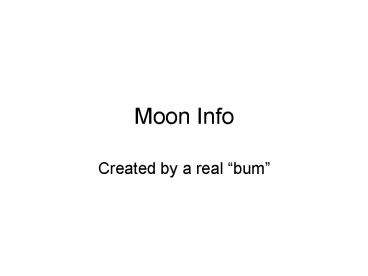Moon Info - PowerPoint PPT Presentation
1 / 20
Title:
Moon Info
Description:
The time it takes the moon to rotate once is equal to the time it takes to orbit ... Tectonic movement (there are no Plates on the Moon) caused by crater impacts. ... – PowerPoint PPT presentation
Number of Views:56
Avg rating:3.0/5.0
Title: Moon Info
1
Moon Info
- Created by a real bum
2
Synchronous Orbit/Rotation
- The time it takes the moon to rotate once is
equal to the time it takes to orbit around the
Earth once. 27.3 days - The same side of the moon is ALWAYS facing the
earth (called nearside). - We cannot see the Farside from Earth. The 1st
time humans saw Farside was 1959 (Soviet
Interplanetary Satellite).
3
(No Transcript)
4
Farside!!!
- Image from Apollo 16. Left side is part of
nearside. - Greater amounts of Craters and virtually no Maria
(dark portions easily visible on Nearside)!!!
5
Earthshine
- dark side of the moon is illuminated by the
Earths reflected light.
6
Formation Theories
- Simultaneous formation- moon and Earth formed
together at the same time from the solar nebula. - Capture Theory- Earths gravity captured a large
planetessimal early in the formation of the SS. - Collision Theory- Mars sized planetessimal
collided with Earth. Ejected material coalesced
to form the moon.
7
Lunar Features
- Oceanus (Ocean)
- Maria (Seas)
- Sinus (Bay)
- Lacus (Lake
- Mountains (Mountains)
- Rille (Valleys)
- Craters (Craters)
- Rays (Bause needs a rays)
8
Oceanus
- Only one. Called Oceanus Procellarum (latin for
ocean of storms) - Basaltic lava flow (ancient 3.5 bya)
- On Western edge of near side
- 4,000,000km2
9
Oceanus Procellarum
10
Mare
- Several (plural is maria). Largest is Mare
Imbrium (Sea of Showers). 1100 km diam. - Basaltic lava flow
- 3.5 bya
11
Mare Imbrium
12
Mare Imbrium
13
Mountains
- Lunar highlands. The lighter portion of the
moon. - Formed from cratering, uplifting from impact.
- Anorthsites- rocks formed from impact (type of
glass) - Elevations can reach 20,000 ft!!! (bigger than
the tallest Rocky mtn)
14
Apollo 15 Landing Site
- Mt. Hadley in background is 15,000 ft high!!!
- Side note
- Curvature of earth is 8 in/mile
- Moon is 48in/mile
15
Rille
- Lunar canyons or valleys.
- 100s of kilometers long.
- Created by (topic is still under debate and
research) - Ancient lava flows
- Tectonic movement (there are no Plates on the
Moon) caused by crater impacts.
16
Ariadaeus Rille Taken by Apollo 10 flyby, 1969
17
Craters
- Impact sites
- Most occurred early moon evolution.
- Young craters have rays- extension of craters.
- Best viewed near the terminator due to the low
sun. - Tycho is the large crater in the southern portion
of the moon.
18
Coppernicus
Tycho
19
Impacts
- 1kg meteor moving 10km/s (called hypervelocity)
releases as much energy as 10kg of TNT. - Unlike Earth, Moon has no atmosphere to protect
from meteors (shooting stars on Earth are usually
caused by a particle the size of sand or a pebble
as they burn in the atm). SO, even sand sized
meteors make MICRO-craters.
20
Fig. 8.14































